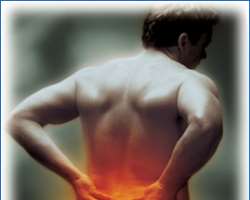AN OFFSPRING OF PROLONGED COMMON WAIST PAIN

Mr. Mukoro said he had pain at the waist in 2007 while trying to help his wife lift a bag of salt she bought at the market from the boot of her car. Suddenly, he had a twinge in his lower back. It was serious. This condition kept him indoors for more than one week while receiving conservative treatment. He got better weeks later, but not without occasional bouts of pain in the waist.
In 2009, just as he sat on a low chair in his parlour to lace his shoes, he experienced serious 'shock' (spasm), while rising up from a the chair, which culminated in excruciating pain spreading fast from the waist through the buttocks to the right leg, with associated numbness and tingling sensation. He has had 'sciatica.'
Indeed, complaints of sciatica abound in my mailbox. The term 'sciatica' describes the symptoms of leg pain and possibly tingling sensation, numbness as mentioned, or weakness that travels from the lower back (waist) through the buttocks and down the large sciatic nerve in the back of the legs. Depending on where the sciatic nerve is pinched determines where you feel the pain, which can radiate to the front of the knee or right down the back of the leg to the foot.
Sciatica can be very severe and debilitating. Vast majority of people, who experience sciatica, get better with time (usually a few weeks or months) and pain relieved with non-surgical sciatica treatment. In today's medicine, the clinical diagnosis of sciatica is referred to as (radiculupathy), which means simply that a disc has protruded from its normal position in the vertebral column and putting pressure on the radicular nerve (nerve root) in the lower back, which form part of sciatic nerve.
An important thing to understand is that 'sciatica' is a symptom or sign of a problem - of something compressing or irritating the nerve roots that compress the sciatic nerve, rather than a medical diagnosis or medical disorder in and of itself. This is an important distinction because it is the underlying diagnosis (not necessarily the symptom of sciatica) that often needs to be treated in order to relieve sciatica nerve pain. The cause of compression can be varied from a slipped disc (also known as a herniated or prolapsed disc), disc degeneration to muscle tension (Piriformis syndrome) or something less common such as tumors, bony growths (stenosis) and infections.
Sciatica occurs most frequently in people between 30 and 50 years of age. Often, a particular event or injury does not cause sciatica, but rather it tends to develop as a result of general wear and tear of the structure of the lower spine. For some people, the pain from sciatica can be severe and debilitating. For others, the pain might be inflammation and irritation, but has potential to get worse. While sciatica can be very painful, it is rare that permanent nerve damage (tissue damage) will result from inflammation and will get better within two weeks to a few months. Also, because the spinal cord is not present in the lower (lumbar) spine, a slipped or herniated disc in this area of the anatomy does not present a danger of paralysis.
Some sciatica symptoms may constitute a medical emergency. Such symptoms include progressive weakness in the leg and bladder/bowel incontinence or dysfunction. Again, if sciatica occurs suddenly, including people who have been diagnosed cancer, take steroid medication, abuse drugs, have unexplained significant weight loss or have HIV, should seek immediate medical attention.
What are symptoms of sciatica?
Sciatica causes pain, a burning sensation, numbness, or tingling radiating from the lower back and upper buttocks down the back of the thigh to the back of the leg. Severe sciatica can make walking difficult, if not impossible. Sometimes the symptoms of sciatica are aggravated by walking or bending at the waist and relieved by lying down. In some patients, mere sneezing or trying to open the mouth to brush or even laugh excitedly could exacerbate sciatic pain.
How is sciatica diagnosed?
Sciatica is diagnosed with a physical examination and medical history. The typical symptoms and certain examination maneouvers help the health-care practitioner to diagnose sciatica. Sometimes, x-rays, films, and other tests, such as CT scan, MRI scan and Electromyogram, are used to further define the exact causes of sciatica.
Sciatica treatment
Sciatica nerve pain is caused by a combination of pressure or inflammation on the sciatic nerve root and treatment is centered on relieving both of the factors. Typical sciatic treatments include a combination of medical treatment and a good physiotherapy. Effective physiotherapy may include varieties of treatment modalities. The medical aspect reduces the (symptom) to enable physiotherapy to be more effective.
